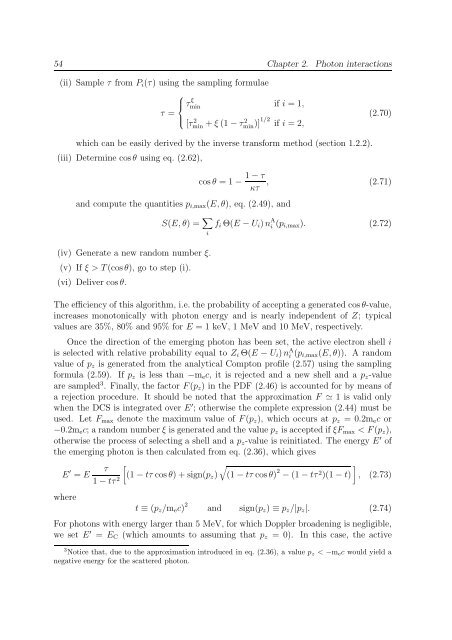PENELOPE 2003 - OECD Nuclear Energy Agency
PENELOPE 2003 - OECD Nuclear Energy Agency
PENELOPE 2003 - OECD Nuclear Energy Agency
You also want an ePaper? Increase the reach of your titles
YUMPU automatically turns print PDFs into web optimized ePapers that Google loves.
54 Chapter 2. Photon interactions<br />
(ii) Sample τ from P i (τ) using the sampling formulae<br />
⎧<br />
⎪⎨ τ ξ min if i = 1,<br />
τ =<br />
⎪⎩ [τmin 2 + ξ (1 − τmin)] 2 1/2 if i = 2,<br />
(2.70)<br />
which can be easily derived by the inverse transform method (section 1.2.2).<br />
(iii) Determine cos θ using eq. (2.62),<br />
and compute the quantities p i,max (E, θ), eq. (2.49), and<br />
cos θ = 1 − 1 − τ<br />
κτ , (2.71)<br />
S(E, θ) = ∑ i<br />
f i Θ(E − U i ) n A i (p i,max ). (2.72)<br />
(iv) Generate a new random number ξ.<br />
(v) If ξ > T (cos θ), go to step (i).<br />
(vi) Deliver cos θ.<br />
The efficiency of this algorithm, i.e. the probability of accepting a generated cos θ-value,<br />
increases monotonically with photon energy and is nearly independent of Z; typical<br />
values are 35%, 80% and 95% for E = 1 keV, 1 MeV and 10 MeV, respectively.<br />
Once the direction of the emerging photon has been set, the active electron shell i<br />
is selected with relative probability equal to Z i Θ(E − U i ) n A i (p i,max (E, θ)). A random<br />
value of p z is generated from the analytical Compton profile (2.57) using the sampling<br />
formula (2.59). If p z is less than −m e c, it is rejected and a new shell and a p z -value<br />
are sampled 3 . Finally, the factor F (p z ) in the PDF (2.46) is accounted for by means of<br />
a rejection procedure. It should be noted that the approximation F ≃ 1 is valid only<br />
when the DCS is integrated over E ′ ; otherwise the complete expression (2.44) must be<br />
used. Let F max denote the maximum value of F (p z ), which occurs at p z = 0.2m e c or<br />
−0.2m e c; a random number ξ is generated and the value p z is accepted if ξF max < F (p z ),<br />
otherwise the process of selecting a shell and a p z -value is reinitiated. The energy E ′ of<br />
the emerging photon is then calculated from eq. (2.36), which gives<br />
E ′ = E<br />
where<br />
[<br />
√<br />
]<br />
τ<br />
(1 − tτ cos θ) + sign(p<br />
1 − tτ 2 z ) (1 − tτ cos θ) 2 − (1 − tτ 2 )(1 − t) , (2.73)<br />
t ≡ (p z /m e c) 2 and sign(p z ) ≡ p z /|p z |. (2.74)<br />
For photons with energy larger than 5 MeV, for which Doppler broadening is negligible,<br />
we set E ′ = E C (which amounts to assuming that p z = 0). In this case, the active<br />
3 Notice that, due to the approximation introduced in eq. (2.36), a value p z < −m e c would yield a<br />
negative energy for the scattered photon.
















